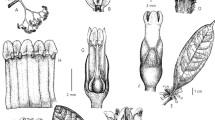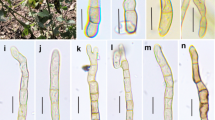Summary
A synopsis of the largely Peruvian genus Englerocharis Muschl. is presented, and the new species E. ancashensis Al-Shehbaz, A. Cano & Trinidad is described and illustrated. An updated generic description of Englerocharis and a key to its four species are given. The generic differences between Englerocharis and Brayopsis Gilg & Muschl. are discussed.
Similar content being viewed by others
Introduction
The genus Englerocharis Muschl. (Brassicaceae or Cruciferae) was established by Muschler (1908) and remained monospecific for over 80 years. It was expanded by Baehni & Macbride (1937) to include three additional species transferred from Brayopsis Gilg & Muschl. However, as shown by Al-Shehbaz (1989), who added the second species in the genus (E. pauciflora Al-Shehbaz), the two genera are substantially distinct morphologically. Englerocharis differs from Brayopsis by having usually bracteate racemes (vs solitary flowers originating from leaf axils of the basal rosette), persistent (vs usually caducous) sepals, and sericeous basal leaves with antrorsely appressed trichomes (vs glabrous or variously pubescent basal leaves with spreading trichomes). Both genera were placed by Schulz (1924, 1936) in the highly artificial tribe Sisymbrieae and were recognised by Appel & Al-Shehbaz (2003) but without a tribal affiliation. Recent molecular studies by Warwick et al. (2009, 2010) have clearly demonstrated that Brayopsis belongs to the tribe Eudemeae, whereas Englerocharis belongs to the remotely related tribe Thelypodieae. Both tribes are restricted to the New World, and Eudemeae can easily be distinguished from the Thelypodieae by the solitary flowers from a basal rosette (vs flowers grouped in racemes).
Extensive fieldwork in Peru by AC and his colleagues in 2010 have lead to the discovery of a third species of Englerocharis, E. dentata Al-Shehbaz & A. Cano (Al-Shehbaz & Cano 2011), and additional fieldwork in 2011 yielded a fourth species described herein as E. ancashensis. Except for E. peruviana Muschl., which grows at elevations of 4300 – 5000 m and is somewhat widespread in Peru but narrowly distributed in Bolivia, the remaining three species (E. dentata, E. ancashensis, E. pauciflora) are Peruvian endemics known thus far only from their type collections. Unfortunately, the precise locality from which the type of E. ancashensis was gathered is not known, and the original collectors only gave the altitudinal range of the general area from which the species was collected. Therefore, the IUCN Red List category (IUCN 2001) of three species remains uncertain and their current assessment is categorised as Data Deficient (DD). A synopsis and expanded generic description of Englerocharis are presented below.
Taxonomy
Englerocharis Muschl. (Muschler 1908: 276).
Type species: E. peruviana Muschl.
Perennial, scapose, cespitose herbs, often cushion forming, with thick, simple or branched caudex densely covered with persistent leaf remains of previous years. Trichomes simple, soft, antrorsely appressed, sericeous. Basal leaves rosulate, petiolate, not fleshy, simple, entire or dentate, densely sericeous, at least distally, rarely subglabrous or ciliate; cauline leaves absent. Racemes few- to many-flowered, lax or dense, ebracteate or basally bracteate, subumbellate, slightly elongated or dense in fruit; rachis straight; fruiting pedicels ascending, persistent, slender or thickened. Sepals oblong to oblong-spatulate, persistent, erect, glabrous or pubescent, base of inner pair not saccate; petals white, longer than sepals, obovate, apex rounded; stamens 6, slightly tetradynamous; anthers oblong; nectar gland 1, confluent, subtending bases of all stamens, lateral nectaries semi-annular; ovules 8 – 16 per ovary. Fruit dehiscent, oblong to oblong-elliptic, terete, sessile; valves glabrous or puberulent; septum complete or perforate, membranous; style to 2 mm; stigma entire. Seeds wingless, ovoid, smooth, not mucilaginous when wetted; cotyledons incumbent.
Key to the species of Englerocharis
-
1. Basal leaves 7 − 9-dentate, 10 − 15 mm wide2. E. dentata
Basal leaves entire, 2 − 8 mm wide........................................................2
-
2. Racemes 8 − 20-flowered; fruit valves pubescent; sepals (3 −) 4 − 6 mm4. E. peruviana
Racemes 2 − 4-flowered; fruit valves glabrous; sepals 1.8 − 2.2 mm........................................................3
-
3. Leaves green, lanceolate, subglabrous or sparsely sericeous adaxially; raceme ebracteate; style in fruit 1 − 1.7 mm3. E. pauciflora
Leaves silvery grey, oblanceolate, densely sericeous adaxially; raceme 1-bracteate; style in fruit 0.2 − 0.3 mm........................................................1. E. ancashensis
1. Englerocharis ancashensis Al-Shehbaz, A. Cano & Trinidad sp. nov. Type: Peru, Dept. Ancash, Prov. Pallasca, Distr. Pampas, Cordillera Pelagatos, rock crevices, 4100 – 4500 m, 0192627 – 0193871 UTM [8°9'42.7" – 8°10'6.5"S], 9095651 – 9096392 UTM [77°46'40.8" – 77°47'21.3"W], 21 April 2011, A. Cano, H. Trinidad, D. Rodríguez-Paredes & D. W. Ramirez 20320, (holotype USM!; isotypes K!, MO!).
http://www.ipni.org/urn:lsid:ipni.org:names:77118121-1
Densely cespitose, scapose perennials; caudex few branched, 1 – 1.5 cm in diam., densely covered with dry persistent leaves of previous years; rosettes 1 – 2 cm in diam., to 7 mm high. Basal leaves rosulate, 5 – 7 × 2 – 3 mm, silvery and densely antrorse sericeous adaxially with simple trichomes 0.4 − 0.5 mm, silvery abaxially on distal half of blade and glabrous on proximal half, apex acute, margin entire, base attenuate to a flattened; petiole glabrous, to 3 mm; cauline leaves absent. Racemes 2-flowered, not elongated in fruit; peduncle 3 – 7 mm, glabrous; bract 1, linear-oblanceolate, 3.5 – 4 × 0.5 – 0.7 mm, sparsely pubescent on adaxial half; pedicels 2 – 4 mm, glabrous. Flowers not seen. Sepals in fruit persistent, oblong, pubescent distally, 2.5 − 3 × c. 1.2 mm. Fruit ovate-elliptic, 3 − 3.5 × 1 − 1.3 mm; valves glabrous; style 0.2 − 0.3 mm; septum perforate. Seeds 8 − 10, ovoid, light brown, 1 − 1.2 × 0.6 − 0.7 mm. Figs 1, 2 and 3.
Distribution. Endemic to Peru and known thus far only from the type collection.
Notes. Englerocharis ancashensis is readily distinguished from the other species of the genus by a combination of its silvery leaves and 2-flowered, 1-bracteate racemes. The only other species with few (2 − 4)-flowered racemes is E. pauciflora, from which it is readily distinguished by the key characters above.
2. Englerocharis dentata Al-Shehbaz & A. Cano (2011: 275). Type: Peru, Dept. Huancavelica, Prov. Huaytará, Pilpichaca, 4 July 2010, 4500 – 4550 m, 523163 [13°18'4.9"S], 8528939 [74°47'10.1"W], A. Cano, W. Mendoza, A. Delgado & E. Navarro 19645 (holotype USM!; isotype MO!).
Distribution. Endemic to Peru and known thus far only from the type collection.
3. Englerocharis pauciflora Al-Shehbaz (1989: 624). Type: Peru, Dept. Junín, Prov. Jauja, Tarma-Jauja road, 28 km from Tarma, in vernal pools, 78°38'W, 11°35'S, 3950 m, 10 Jan. 1984, D. N. Smith 5684 (holotype GH!; isotype MO!).
Distribution. Endemic to Peru and known thus far only from the type collection.
4. Englerocharis peruviana Muschl. (Muschler 1908: 276). Type: Peru, Dept. Junín, Lima-Oroya road, above Hacienda Arapa, near Yauli, 4600 m, 18 − 27 Jan. 1902, A. Weberbauer 331 (holotype, B!; fragments BAA!).
Englerocharis peruviana var. leiocarpa O. E. Schulz (1924: 197). Type: Peru, Dept. Ancash, Prov. Pallasca, Cordillera Pelagatos, 4450 m, 28 Jan. 1920, A. Weberbauer 7231 (holotype B!; isotypes F!, US!).
Distribution. Bolivia (La Paz), Peru (Ancash, Apurímac, Huancavelica, Junín, La Líbertad, Lima).
References
Al-Shehbaz, I. A. (1989). The South American genera Brayopsis and Englerocharis (Brassicaceae). Nordic J. Bot. 8: 619 – 625.
____ & Cano, A. (2011). Englerocharis dentata and Eudema peruviana (Brassicaceae), two new species from Peru. Harvard Pap. Bot. 16: 275 – 278.
Appel, O. & Al-Shehbaz, I. A. (2003). Cruciferae. In: K. Kubitzki (ed.), Families and Genera of Vascular Plants. 5: 75 − 174. Springer-Verlag, Berlin, Heidelberg.
Baehni, C. & Macbride, J. F. (1937). Remarques sur les Cruciferae — Sisymbrieae. Candollea 7: 291 – 296.
IUCN (2001). IUCN Red List Categories and Criteria, Version 3.1. Prepared by the IUCN Species Survival Commission. IUCN, Gland and Cambridge.
Muschler, R. (1908). Cruciferae Andinae. Bot. Jahrb. Syst. 40: 267 – 277.
Schulz, O. E. (1924). Cruciferae – Sisymbrieae. In: A. Engler (ed.), Das Pflanzenreich. IV (Heft 86): 1 – 388. Wilhelm Englemann, Leipzig.
____ (1936). Cruciferae. In: A. Engler & K. Prantl (eds), Die Natürlichen Pflanzenfamilien, 2nd edition, H. Harms (ed), 17B: 227 – 658. Wilhelm Engelmann, Leipzig.
Warwick, S. I., Sauder, C. A., Mayer, M. S. & Al-Shehbaz, I. A. (2009). Phylogenetic relationships in the tribes Schizopetaleae and Thelypodieae (Brassicaceae) based on nuclear ribosomal ITS region and plastid ndhF DNA sequences. Botany 87: 961 – 985.
____, Mummenhoff, K., Sauder, C. A., Koch, M. A. & Al-Shehbaz, I. A. (2010). Closing the gaps: Phylogenetic relationships in the Brassicaceae based on DNA sequence data of nuclear ribosomal ITS. Pl. Syst. Evol. 285: 209 – 232.
Acknowledgements
AC is grateful for the financial support of the National Science Foundation to Kenneth R. Young (DEB 1010381) and to Facultad de Ciencias Biológicas of the Universidad Nacional Mayor de San Marcos for administrative facilities. He also thanks his colleagues and students for their collaboration. We thank the curators and directors of the herbaria cited.
Author information
Authors and Affiliations
Corresponding author
Rights and permissions
About this article
Cite this article
Al-Shehbaz, I.A., Cano, A. & Trinidad, H. Englerocharis ancashensis (Brassicaceae), a new species from Peru and a synopsis of the genus. Kew Bull 67, 251–255 (2012). https://doi.org/10.1007/s12225-012-9343-y
Accepted:
Published:
Issue Date:
DOI: https://doi.org/10.1007/s12225-012-9343-y







